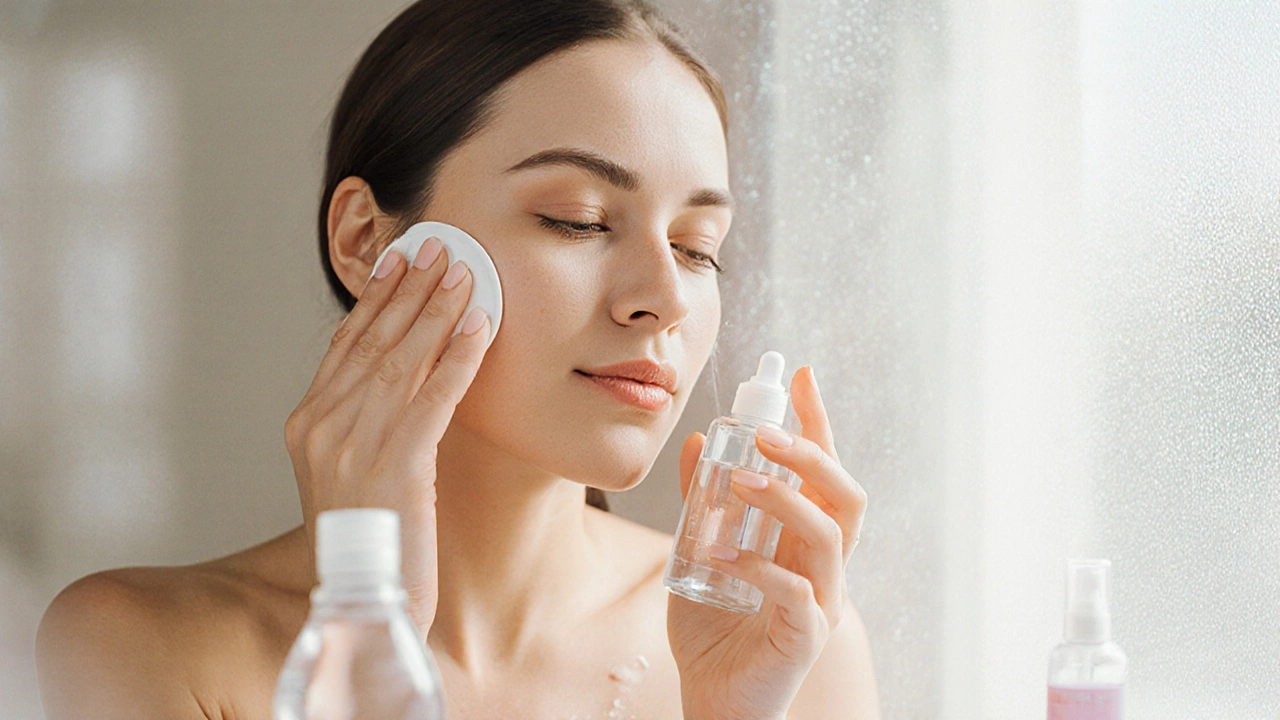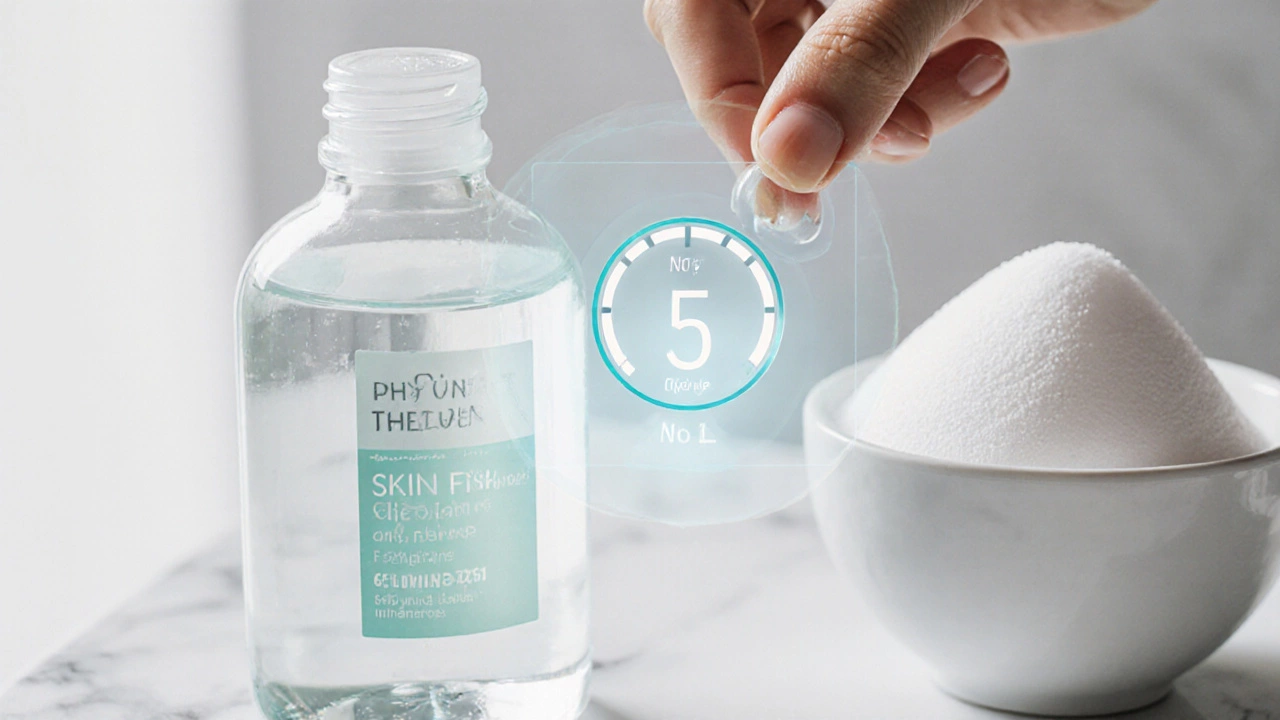Toner Recommendation Tool
Find Your Perfect Toner Match
Answer a few quick questions to discover which toner type works best for your skin.
Your Recommended Toner
When you hear the word Toner is a water‑based skincare product designed to refine the skin’s surface, restore pH, and prep for the next steps, you might wonder if it’s a must‑have or just hype. In today’s crowded market, the answer isn’t a simple yes or no-it depends on your skin, your routine, and the kind of results you’re after.
What Exactly Does a Toner Do?
At its core, a toner is a liquid that follows cleansing and precedes serum or moisturizer. It has three main jobs:
- pH balancing: Your skin’s natural pH sits around 5.5. Harsh cleansers can push it up, leaving the skin slightly alkaline and prone to irritation. A good toner nudges the pH back to its sweet spot.
- Removing residue: Even the best cleanser can leave behind trace oil, makeup, or hard‑water minerals. Toner sweeps those leftovers away.
- Pre‑hydrating: Many modern toners contain humectants like hyaluronic acid, which attract water into the skin and create a moisture‑friendly canvas for the layers that follow.
If you skip this step, you’re essentially asking your moisturizer to work on a surface that’s still a bit rough or out of balance.
When Does Toner Actually Make Sense?
Not every routine needs a toner, but here are the scenarios where it shines:
- Oily or acne‑prone skin: An astringent toner with ingredients like witch hazel or salicylic acid can help control excess sebum without over‑drying.
- Dry or dehydrated skin: Hydrating toners packed with glycerin or hyaluronic acid restore moisture after a foaming cleanser.
- Exfoliation lovers: Chemical exfoliant toners (glycolic, lactic, or mandelic acid) give a gentle, daily polish that a weekly mask can’t match.
- Complex routines: If you layer serums, a toner ensures each product penetrates better, maximizing the benefits of actives like niacinamide or vitamin C.
Conversely, if you have extremely sensitive skin that reacts to fragrance or alcohol, you might opt for a minimalist routine and skip the toner altogether.
Types of Toner and How to Choose
Below is a quick snapshot of the most common toner families. Use the table to match the formula to your skin’s needs.
| Type | Key Ingredients | Best For | Main Benefit | Typical Price (USD) |
|---|---|---|---|---|
| Hydrating | Glycerin, Hyaluronic Acid, Aloe Vera | Dry, Dehydrated, Mature | Instant moisture, plumps fine lines | $15‑$30 |
| Astringent | Witch Hazel, Hamamelis, Salicylic Acid | Oily, Acne‑prone | Reduces shine, tightens pores | $12‑$25 |
| Exfoliating (Acid) | Glycolic Acid, Lactic Acid, Mandelic Acid | Texture concerns, dullness | Gently resurfaces, boosts radiance | $20‑$40 |
| pH‑Balancing | Apple Cider Vinegar, Rose Water, Niacinamide | All skin types (especially post‑cleanse) | Restores natural acidity, calms irritation | $10‑$22 |
| Essence‑Like | Fermented extracts, Peptides | Combination, anti‑aging enthusiasts | Boosts cell turnover, adds glow | $30‑$55 |
Notice how the price range overlaps-don’t assume a higher price always means better results. The real differentiator is the actives that align with your skin’s current needs.
How to Fit Toner Into Your Daily Routine
- Cleanse: Use a gentle cleanser suited to your skin type. Rinse with lukewarm water.
- Apply toner: Pour a few drops onto a cotton pad or directly into your palms. Pat gently over the face, avoiding the eye area. If the formula is alcohol‑free, you can skip the cotton pad and press it in with your hands for extra hydration.
- Layer actives: Follow with serums (vitamin C in the morning, retinol at night) so they absorb more efficiently.
- Moisturize: Seal in the hydration with a moisturizer or a facial oil.
- Sun protection: In the AM, finish with SPF 30+ to protect the newly exposed skin layers.
For evening routines that include an exfoliating toner, keep the frequency to 2‑3 times a week to avoid over‑doing it.
Common Mistakes & How to Avoid Them
- Choosing a tone‑only for “trendy” reasons: Not every product marketed as a toner delivers pH balance or hydration. Read the ingredient list; look for humectants and avoid high alcohol percentages (>10%).
- Over‑applying: A dime‑sized amount is enough for the whole face. Too much can strip the skin or cause stinging.
- Mixing incompatible actives: Acidic exfoliating toners and vitamin C serums can cancel each other out. Use them at opposite times of day or on alternate days.
- Skipping the patch test: Even “gentle” formulas can trigger reactions. Apply a thin layer on the jawline and wait 24 hours before full‑face use.
- Forgetting the storage tip: Keep toners in a cool, dark place. Exposure to light degrades many active ingredients, especially AHAs.

Alternatives If You Decide to Skip Toner
Sometimes a simpler routine works better. Here are three substitute steps you can try:
- Micellar Water as a Second Cleanse: A gentle, no‑rinse option that removes residual makeup and leaves a light moisturizing film.
- Essence or Hydrating Serum: Products like a hyaluronic‑acid essence deliver the same pre‑moisture benefit without the extra step.
- Rose Water Spray: A natural, alcohol‑free spray can reset pH and soothe skin between layers.
These alternatives can be just as effective, especially if you have very sensitive skin or a minimalist mindset.
Quick Checklist Before You Buy
- Identify your skin type (oily, dry, combination, sensitive).
- Match the toner type to a specific need (hydration, oil control, exfoliation).
- Check the ingredient list for alcohol < 5% and at least one humectant.
- Consider price per ounce - a $30 bottle lasting 3 months is a better deal than a $15 one that runs out in a month.
- Patch test before full use.
With these points in mind, you can decide confidently whether a toner belongs in your skincare toolbox.
Frequently Asked Questions
Do I need a toner if I already use a serum?
A serum targets specific concerns like brightening or anti‑aging, while a toner prepares the skin so those actives can penetrate better. If your serum feels “thin” on the skin or you notice uneven texture, a toner can fill that gap.
Can I use a toner twice a day?
Yes, as long as the formula is gentle and alcohol‑free. Hydrating or pH‑balancing toners are safe for morning and night. Exfoliating toners should be limited to 2‑3 times weekly to prevent irritation.
Is alcohol in a toner always bad?
Not necessarily. Low‑percentage alcohol (under 5%) can help the product dry quickly without being harsh. High‑alcohol formulas can strip natural oils and trigger redness, especially on sensitive skin.
Should I apply toner before or after a facial oil?
Always before. Toner’s job is to balance and hydrate, creating a receptive base. Oils seal the moisture, so they should be the last step in a routine.
What’s the difference between a toner and an essence?
Essences are typically more concentrated, often containing fermented ingredients and peptides, and are marketed as a “step between toner and serum.” Toners focus on pH balance and light hydration. Some brands merge the two into an “essence‑toner” hybrid.
